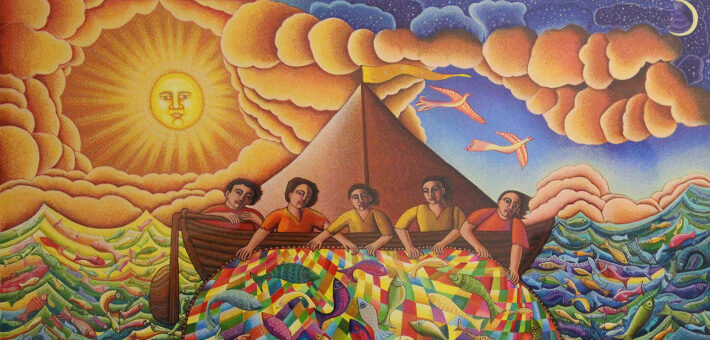Commentary on Genesis 2:4b-7, 15-17; 3:1-8
After a first, poetic account in Genesis 1, Genesis 2-3 offers a complementary narrative account of the beginnings of creation.1
Together these three chapters present creation through a bifocal lens that affirms both the profound, inherent goodness of creation (Genesis 1) and the complexities and ambiguities of life within that good creation (Genesis 2-3).
In Genesis 2:7, the human being is the ‘adam brought forth from the ground, the ‘adamah. Even though the human being’s appearance precedes that of other non-human animals, this earth creature is not given “dominion” as in Genesis 1, but is called “to serve” [‘abad] the ground (2:15). Translations have obscured this fundamental relationship between ‘adam and ‘adamah. The New Revised Standard Version, for instance, has: “The LORD God took the man and put him in the garden of Eden to till it (New International Version: “to work it”; Common English Bible: “to farm it” New Jerusalem Bible; and others, “to cultivate it”). The verb ‘abad loses its semantic resonance (the root is connected to worship) when thinned down to “till”, “work”, “farm”, or “cultivate.” In this context, as a transitive verb, it means “to serve” the Garden of Eden, to “work for” it. As Theodore Hiebert observes in his book, The Yahwist’s Landscape (63-66), Genesis 2 pictures the human’s role not as ruler but as groundskeeper or tenant farmer. The other instances of this verb in relation to agriculture (Genesis 4:2, 12; Deuteronomy 15:19; 28:39; 2 Samuel 9:10; Zechariah 13:5; Isaiah 19:9; 30:24) do nothing to suggest a relationship of rule or even ownership in relation to the ground — the work described is humble, albeit necessary.
Sharp distinctions between humans and animals are difficult to draw from Genesis 2. Both humans and animals are called nephesh hayah, living creatures. This phrase applies to aquatic life (Genesis 1:20, 21), land animals (v. 24; 2:19; 9:10), birds (9:10), and in fact “all flesh” (9:15, 16) — and in 2:7 it also applies to humans. Translators have obscured this: almost all recent Bibles read, “living being” for the man in Genesis 2:7, and “living creatures” for animals everywhere else. But the ancient writer did not make this distinction. We are all nephesh hayah, whether raccoon, meerkat, or human.
In addition, whereas in Genesis 1 each group of living creatures arises from its own habitat, in Genesis 2 we all come from the same place. In this agriculturally-infused story, humans are formed from the ground just as all other life is: “Then the LORD God shaped the ‘adam from dust from the ground … ” (2:7): “Then the LORD God caused to grow from the ground every tree … ” (2:9); “Then the LORD God shaped from the ground every animal of the field and every bird of the air … every living creature” (2:19).
God’s making and bringing potential animal helpers to the ‘adam is not mere trial and error. Rather, God discovers that for this creature, aloneness is not good — human beings need companionship, relationality, human community. God’s assessment that being alone is not good is in stark contrast to the affirmation of creational goodness that echoes throughout Genesis 1. Animals do provide some measure of companionship, but they do not address the fundamental aloneness of the ‘adam.
So God declares: “I will make it a helper as its partner” (Genesis 2:18). The word “helper” implies that the problem is not loneliness alone, but the need for someone to aid in the farm work God has given to the ‘adam (Hiebert, 60). In ancient agrarian economies, animals indeed lived and worked alongside humans, as they do today in many places. The woman is part of the larger farming project (“to serve and preserve” the garden, as Ellen Davis translates it in Scripture, Culture, and Agriculture), yet the woman is also human like the man, “bone of my bones and flesh of my flesh” (Genesis 2:23).
Phyllis Trible argued persuasively in her groundbreaking 1978 book, God and the Rhetoric of Sexuality, that “helper” bears no connotations of subordination in the original Hebrew (the English word “helper” conjures someone with a rank of “prep cook,” the lowest rung in the kitchen staff hierarchy). In the Hebrew Bible, God is sometimes referred to as Israel’s “helper,” as in Psalm 70:5 (Hebrew v. 6):
But I am poor and needy;
hasten to me, O God!
You are my helper and my deliverer (cf. Psalm 33:20).
In short, the term does not convey anything about hierarchical status, but instead points toward the need to fulfill a particular task. The two humans are partners in serving the garden, the ground from which they came.
In Genesis 3 the great central act of disobedience is introduced. In choosing to disobey God’s command, the humans radically alter their perception of themselves and of their world. Their eyes are opened and they become self-aware. Where they had been living in a theocentric world, now they believe they live in an anthropocentric one, in which they can assert themselves as the center of value, decision-making, and knowledge. The knowledge they gain from eating the fruit results in alienation in their relationship with God and also with the soil, the adamah to which they are integrally related (3:17).
A key difference emerges between Genesis 1 and 2-3 concerning the human condition: in Genesis 1, human beings are made in the image and likeness of God, and all is harmony. In Genesis 2-3, when human beings begin to be like God, conflict arises (“you will be like God/gods,” says the snake in Genesis 3:5; later God is concerned that “the ‘adam has become like one of us,” 3:22). There is a tension here, but it is a productive tension in that it reflects the truth of the human condition — we are like God in many ways, and we are profoundly not like God in our creatureliness and finitude. The writers express a profound ambivalence about the human condition, beautifully expressed by the Old Testament scholar Patrick Miller, “the whole narrative of the Primeval History flows out of this tension between being created like God and seeking to become God. One points to the human possibility; the other to its plight.”
Notes
- Commentary first published on this site on Sept. 11, 2016.
PRAYER OF THE DAY
Lord God, grand architect of the universe,
Your design of creation is unflawed. Yet we continue to litter your creation with defects and imperfections. Show us how not to destroy, but to create, not to demean, but to uplift, not to hate, but to love, so that your creation may be made perfect once again. Amen.
HYMNS
Creating God, your fingers trace ELW 684, H82 394, 395, NCH 462, UMH 109
Forgive our sins as we forgive ELW 605, H82 674
Praise the Lord, rise up rejoicing ELW 544, H82 334
CHORAL
O Wisdom, William Beckstrand (MorningStar)
Do Not Leave Your Cares at the Door, Elizabeth Alexander (Seafarer)


September 13, 2020